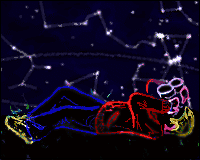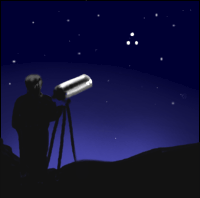Gnomon's Star Guide
Created | Updated Nov 16, 2017

Like every other page on this site, this page looks worst in Classic Goo.
I hope to collect here information about things to look at in the sky. The h2g2 Edited Guide Constellation entries list all sorts of interesting things but many of them can only be seen with the Hubble Space Telescope. My lists will be more humble. I'll try and divide things into Naked Eye, Binoculars and Small Telescope (4 inch / 100mm, because that's what I've got). I have a range of eyepieces for the telescope, giving magnifications from about 15X to about 160X.
Naked Eye Objects

The Moon

Watch out for the thin crescent of the New Moon in the evening sky just after sunset. The thinner the better!
When the moon is full, look for the face of the Man in the Moon.
The Milky Way
On a good dark, starry night, it is always possible to see the Milky Way, a broad strip of faint light behind the stars. The Milky Way is actually made of millions of stars very far away, and is the more distant parts of the galaxy we live in. With one or two exceptions, everything you can see in the sky with the naked eye is part of this galaxy, which is generally called the Milky Way Galaxy.
Flashing Sirius
Sirius is the brightest star in the night sky. This is because it is quite a big star, and it is one of the closest stars to us. Sirius is normally white, but when it is low down in the sky, it appears to flash with different colours. It doesn't do this when it is high in the sky. What is happening is that pockets of air of different temperatures in our atmosphere act as tiny prisms, splitting up the light from the star into tiny rainbows. As the air moves around, we see different colours and it appears to flash. This effect happens to all stars but is most noticeable with Sirius because it is so bright.
Binocular Beauties

Binoculars are best for looking at fields of stars and loose clusters, such as the Pleiades, Praesepe and the Hyades. The stars in these groups are too far apart to be viewed at high magnification.
You can also use binoculars to see some double stars. Many of the stars in the sky are actually pairs of stars very close together. In some cases, they are two unrelated stars, one relatively close to us and the other far away, where one just happens to be in front of the other. These are called 'optical doubles'. In most cases, however, the two stars are actually close to each other, tied together by gravity. These are called binary stars or double stars. If one is much bigger than the other, then the smaller star will orbit around the bigger one. If they're about the same size, they'll spin around each other like dancers.
Being able to see the individual stars in a pair is known as 'resolving' the double star. The better the binoculars, the better 'resolution' they will have.
Mizar and Alcor in the Plough / Big Dipper are quite clearly separate stars through binoculars, and you should be able to see the double star Epsilon Lyrae.
Telescopic Treasures

Double Stars
Double stars can be quite striking when viewed through a telescope. Stars themselves don't look any bigger when viewed through a telecope. They are still just points of light. But two stars together can be interesting, particularly if they are different colours.
Epsilon Lyrae
Magnification: 75X
This is an example of a widely spaced double star where the two components are the same colour and magnitude. This looks reasonably impressive at 25X and is even visible with binoculars. In fact, each of the two stars is itself a double, but you need a more powerful telescope to see it. This is not visible at 75X. I'll try it again in a few weeks at 165X.
Mizar - Zeta Ursae Majoris
Magnification: 75X
Anybody looking at Mizar can see that there is another faint star near it. This is called Alcor. With binoculars you may be able to see another star, Ludwig's Star, about half way between Mizar and Alcor. Ludwig's Star is nothing to do with Mizar and Alcor - it's a distant star in the background. With a telescope, it can be seen that Mizar itself is a double star, both components being the same colour but one much brighter than the other.
Albireo - Beta Cygni
Magnification: 75X
Albireo is a beautiful example of a double star where the two components are quite different from each other in colour. There is a bright yellow star and a faint blue one.
Messier Objects
Messier Objects are a mixed bag, with star clusters, nebulas and galaxies. Most Messier objects are disappointing, even through a small telescope. Photos taken of vast glowing clouds of gas are misleading because they are accumulated over hours of exposure. To the naked eye, most Messier objects are indistinct grey blurs.
M57 - the Ring Nebula
Magnification: 75X
This is a 'planetary nebula', so-called because it might be mistaken for a planet. It is in fact the dust shell thrown off by an exploding supernova. M57 is a noticeable ring shape, but at 75X it is only barely visible as a ring. When I look straight at it, I see a grey blob. When I look to one side I can see what looks like a ring of smoke.
M31 - the Great Spiral Galaxy in Andromeda
One of the most celebrated Messier objects, this is the biggest galaxy in our Local Group, about 50% bigger than our own galaxy. It appears seven times as big as the full moon in our sky, but is so faint that in a 100mm telescope, all that you can see is a faint grey smudge. This is actually the slightly brighter core of the galaxy. M31 is claimed to be the furthest distant object that is visible to the naked eye. Well, my eyesight isn't good enough to see it even with my glasses, but my daughters can. It's about 2 million light years away.
M42 - the Great Nebula in Orion
Magnification: 165X
On a good clear night, this is really classy. It's hard to relate what you see in the telescope to the photos, because they cover a much larger area and are collected over hours of exposure. Look out in particular for the trapezium - three bright stars and one faint one very close together at the centre of the nebula.
M45 - the Pleiades
Magnification: 17X
This is a beautiful cluster of blue stars. It really needs to be viewed at low magnification, as you'll miss the outer stars if the magnification is any higher. Although the cluster looks blurry to the naked eye, that's just a defect in our vision. The stars do have a trace of nebulosity, but it's not visible in an amateur telescope and is only detectable in photos.
Planets
Through a small telescope, the planets don't look particularly special. Most of them just look like very small spheres. There are three special sights to look out for, though.
Venus is a crescent when it is at its brightest, which comes as a surprise to most people. You won't see any markings on it, and it has no moons, so there's nothing to see but a pure white crescent on a dark blue sky, but it's worth it.
Jupiter itself doesn't have much in the line of features, but it has four big moons. These can be seen even with binoculars, and possibly by people with very good eyesight. (My father thought he could see them but wasn't sure.) At 165X, the disc is very clear and it is just possible to make out two horizontal dark stripes. The four main moons are really obvious at this magnification. Perhaps on a good night, it might be possible to see the Great Red Spot.
Saturn's rings are just barely visible at 25X and definitely visible at 75X, but it is still tiny. I haven't yet seen it through the 165X eyepiece. Saturn also has some noticeable moons.
Some Technical Stuff
Stellar Magnitudes
Stellar brightness (as seen from Earth) is given by a figure called apparent magnitude, normally just called magnitude. Magnitudes are calculated by a strange formula:
m = -2.5 Log10(k*b) where b is the brightness of the star in some units and k is some constant or other.
This means that:
- Magnitude numbers go the wrong way - the bigger the number, the dimmer the star
- Stars of each magnitude are about 2.51 times as bright as ones of the next magnitude. But this is not noticeable to the human eye because the eye has a roughly logarithmic reponse, so that stars appear to match the magnitude numbers.
- If two stars are very close together, they appear to be one star but you can't just add the magnitudes to get the magnitude of the resultant star. You have to use a complicated formula.
To add two magnitudes together:
m = -2.5 Log[10^(-m1/2.5) + 10^(-m2/2.5)]
Stellar Distance
Stellar distance may be given in three different ways:
- Parallax, measured in arcseconds.
- Distance in parsecs.
- Distance in light years.
The first two of these are related to each other - distance in parsecs is 1 divided by parallax (and vice versa). It's easier to convert everything to light years, which everybody understands:
- To convert parallax to light years, divide 3.2616 by the parallax.
- To convert parsecs to light years, multiply by 3.2616.
Choosing a Telescope
The first thing to do is choose the telescope mount:
If you want to take long-exposure photographs, you need an equatorial mount. There's no way around this - even with computerised tracking, you can't use an altazimuth mount for stellar photography, because the tube turns relative to the background as the 'scope tracks the star.
Astronomy Pictures
I've collected together a lot of pictures and diagrams relating to astronomy at the Gnomon Astronomy Picture Library. You can use these in your own pages.
